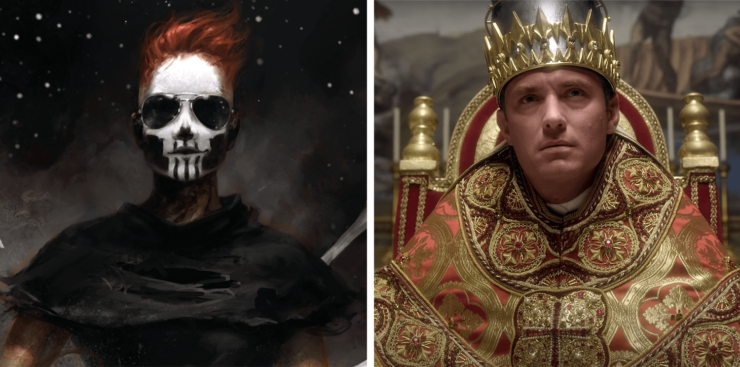Let us assume, for the sake of this essay, that most of the really great things about Catholicism come from queerness. The focus on aesthetics, the dedication to DRAMA, the development of theater, the devotion to art and study, the clothing, all of Michelangelo’s painting and sculpture, the longing, the devotion.
Gideon the Ninth is both extremely queer and extremely Catholic.
[Warning: contains spoilers for Gideon the Ninth.]
The queerness comes through in, well, everything, but especially in Gideon’s willingness to be Dulcinea’s fool, in her love of dad jokes, in her enemies-to-lovers adoration of Harrow. Gideon’s responses to problems are very butch, ranging from “how can use body to fix thing?” all the way to “fix thing with stab?” Queerest of all, this tendency has a resolution as beautiful as it is a tragic. We’ll come back to this when I talk about Catholicism. And I mean, THAT SWORD—Gideon can handle any sword, and learn to use them well despite size or shape, her favorite is a big! Dumb! Broadsword!
But wait, let me give you a definition of queerness real quick, so we’re at least in the same chapter, if not on the same page. Queer used to mean weird as well as, you know, homosexual. Then it was a pejorative, then it was reclaimed, and now some people in the LGBTQ+ community have rejected that reclamation because they think the word is too hurtful. I respect that, (and if people ask me to use other terms in their presence I absolutely will) but I also, personally, love “queer”. I love saying it, I love being it, because it’s nebulous—it isn’t about anything as basic as who you’re attracted to, it’s more of a way of looking at life and the world. I knew I was queer long before I ever hit puberty, which, when it hit, felt like I was watching the other kids close door after door, until they were boxed into one tiny room. (Looking back, I realize this isn’t fair of me at all—each of those kids was going through their own shit that I knew nothing about. But what I remember is the sheer terror of knowing I was supposed to be following their lead, and refusing.) As an example? Think of how, in Phillip Pullman’s His Dark Materials trilogy, the children’s daemons shift and change constantly. According to Pullman this is a mark of youth, and by the time each person reaches maturity their daemon will settle into a single form. But like, why? Why the hell would you want your daemon—a beautiful walking metaphor for your soul—to be trapped in a fixed state? I confess that reading those books for the first time I hoped that the whole daemon-sticking thing would be revealed as just another part of a repressive social structure, and that Lyra’s daemon would stay changeable. Instead Pantalaimon settles because of Lyra’s boyfriend pets his fur? Which is the worst possible scenario, imo? And then Lyra marches off into adult womanhood with a newfound maturity that completely contradicts her entire fucking character. Ahem. But, again:
Why accept a fixed state at all? Why limit yourself? Why close doors when you can leave them wide open? And what is Gideon about, really, if not the opening of locked doors?
As for the book’s relation to Catholicism, references are scattered into this sucker like black pepper from an overzealous waiter on his first day on the job at a good Italian restaurant. To put this in a neat bulleted list (and please remember this is not everything, just a sampling of imagery):
- The Ninth House is at heart an ossuary;
- It is dedicated to the preservation of relics;
- Members of the Ninth pray with bone rosaries;
- They chant memorized prayers in unison;
- We don’t see any (?) direct, internal address to deity;
- We don’t see any (?) discussion/interpretation of beliefs;
- Gideon has attempted to enlist in the Cohort (i.e. military) thirty-three times;
- Gideon is the sole survivor of a massacre of innocents;
- Her mother was a refugee;
- Who even knows who her dad was;
- Gideon truly becomes Harrow’s cavalier during an intense conversation in a pool together—essentially a baptism into a new life;
- She sacrifices herself so her partner can live long enough to serve their God;
- This sacrifice is accomplished by spearing herself on a pointy thing.
Plus, to just grab the two most prominent names, “Gideon” was a Hebrew military leader in the Book of Judges who destroyed icons of other religions. During the Reformation, his story was used by Protestants as a teaching tool when they fought against the Catholic use of saint’s relics in worship, and in our modern world, the “Gideons International” are the evangelical organization that leaves copies of the Hebrew Bible/New Testament in hotel room nightstands. “Harrow” is what Jesus did to Hell when he dropped in for a couple days after the Crucifixion.
Buy the Book
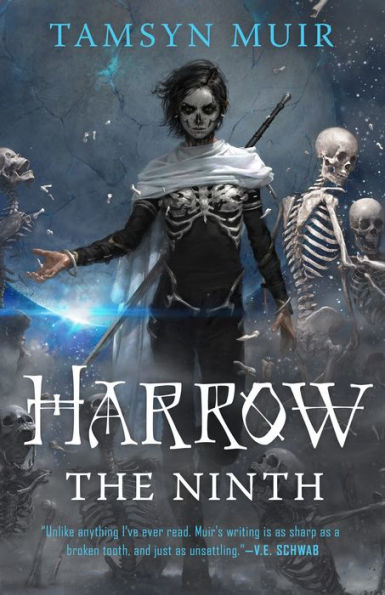

Harrow the Ninth
Muir also gives us a fascinating set piece that establishes the Ninth as the keepers of an outsider religion. When Gideon and Harrow meet the other Houses, Teacher asks them all to “pray for the lord of that which was destroyed, remembering the abundance of his pity, his power, and his love.” There follows a prayer that Gideon, who has been forced to attend church in the Ninth House her entire life, has never heard before. “There was only one prayer on the Ninth. All other services were call-and-speaks or knucklebone orison.” Gideon watches everyone recite, and is then startled when Teacher turns to her and Harrow. “And perhaps the Devout of the Locked Tomb will favor us with an intercession?” Harrow hands Gideon her cup, and recites the Ninth’s prayer, and Gideon’s feeling of alienation deepens:
Gideon had known on some basic level that the religion practiced in the dark depths of Drearburh was not quite the religion practised by the other Houses. It was still a shock to the system to have it confirmed. By the expressions on some of the faces—bewildered or blank or long-suffering or, in at least one case, openly hostile—the other hadn’t been confronted with it either. By the time Harrow had finished the three priests looked softly delighted.
“Just as it always was,” sighed the little bent priest in ecstasy, despite the wretched dirge.
Now I don’t want to make too many assumptions about people, but my own experience plus a brief poll of friends from across the U.S. has shored up my theory that this scene encapsulates an experience particular to Catholics (or, I assume the Eastern Orthodox) in most of this country. Nominally, you are part of the dominant culture. In practice, you are once again explaining why you have dirt on your face, or that no, you can’t come to Happy Hour, because you gave up whiskey for Lent (n.b.: I have never given up whiskey for Lent), or whatever, and feeling like you’re a Medieval relic come to life in the modern world. Gideon has always known she and the Ninth are weird, but she never knew how weird. And she didn’t expect people to be so openly disgusted by the practice she was raised in—the practice she doesn’t even believe in, particularly.
And let’s dig into that prayer for a sec, shall we?
“I pray the tomb is shut forever,” recited Harrowhark, with the curious fervidity she always showed in prayer. “I pray the rock is never rolled away. I pray that which is buried remains buried, insensate, in perpetual rest with closed eyes and stilled brain. I pray it lives, I pray it sleeps…
Now this is a great inversion given that in Christianity, whenever anyone mentions a tomb with a rock in front of it, the whole point is that the rock is rolled away, the tomb is empty, and the dead rabblerouser who was in there has come back to life—after that brief sojourn in Hell I mentioned above. Muir has created a minority religion, an Othered Space Catholicism that centers on a tomb that must stay locked in order to protect humanity from the resurrection of a monster. Rather than asking for “lux perpetua luceat eis” this sect asks that the dead “remain buried, insensate, in perpetual rest.”
But the best way to understand the imagery permeating Gideon is the way it writes pain into every part of its story. Please understand I’m going to be trafficking in some generalities here, but Catholicism is embodied while Protestantism is em–brained. Early Protestants latched onto the nerdy idea that the purest practice of religion came through the close study of the Hebrew Bible and New Testament, an idea called sola scriptura. Catholicism, on the other hand, is all about hard work and toil and, ultimately, failure—which can only be redeemed by grace, maybe, if grace feels like it. Catholicism is very much about learning through pain, and being put on earth to suffer, because suffering is how you learn. The suffering is the actual reason the Hobbits have to walk through Mordor. It’s why The Two Towers is so long. There’s a reason that one of the greatest Catholic organizations is called the Catholic Workers, and that the Jesuits and the Knights of Columbus both invoke military structures and honor codes. There’s a reason Daredevil is always so beat up. Once you fold Original Sin into your structure of the universe, you have to reckon with it, right? You have to pay it off. It was Catholics who took the idea of the “Third Place” of Purgatory and fucking ran with it—the idea that when you die it isn’t just a binary option, joy in heaven or despair in hell. No, there’s a third option, one where you have to keep working, in some pain but not an unbearable amount, until you’ve burned off the sins you accrued in life. It is a way to step out of the binary of good/evil, heaven/hell. It is a queering of death.
This is written into every crunched bone and drop of blood in Gideon the Ninth. Gideon sees the Ninth House as hell, she is tortured there, in a state of despair that she will never escape. Each escape attempt is her trying to reach a wholly different life—a heaven if you will—and thus the journey to First House becomes her Purgatory. She has hope that she’ll finally be free, but along the way there is so. Much. Work. And Harrow? She has dedicated her entire being to study, yes, but her study is made physical through bone magic, and she and literally sweats blood when she does it. Sola scriptura this is not.
Gideon defines herself by pain. I’ll admit that it was difficult for me to read the opening fifty pages of the book because seeing her get knocked down again and again only to drag herself back up and spit out a terrible joke along with some blood and broken teeth—well, it was upsetting to me to read. But as I settled into the book’s rhythms and saw what it was doing, it became clearer that Gideon, as well as being a character in her own right, was also a walking symbol of the mortification of the flesh. She has to be hungry all the time, obsessed with porno mags, and nursing crushes on every pretty girl she meets. She has to treat her body like a sword to be tempered, and she has to absorb pain. That’s the only way she can balance Harrow’s starved body and ravenous intellect.
Because to go a little further, Gideon and Harrow are two halves of a good Jesuit – one half cavalier and one half obsessive scholar. Put ‘em together and you get exactly the person Ignatius of Loyola was gunning for. (Except for the part where they’re girls, and gay, but hell, nobody’s perfect—not even Ignatius of Loyola.)
And here’s where Paolo Sorrentino’s brilliant Young/New Pope series comes crashing in to Gideon’s Catholic space adventure. You see, there’s also The Aesthetic. And I don’t mean the sleek pastels so beloved of Vaporwave A E S T H E T I C, I mean the velvet, the incense, the chanting, the jewel-encrusted bones of the saints that have become part of the DNA of Catholicism. The aesthetic is so ingrained in a certain kind of psyche that, well, a small sampling from Twitter:
not to be c*thol*c on main but sometimes I do want to be wearing an ornate robe and slumped over a stone slab in candlelit prayer
— JP (@jpbrammer) July 25, 2020
https://t.co/CTZfmbp8R7 pic.twitter.com/moakA52fWY
— Isaac Fitzgerald (@IsaacFitzgerald) July 22, 2020
Much of the aesthetic I’ve been circling is so much red velvet spread over the hard wood of a kneeler, because the key is that it’s all just a mask for pain. Excruciating torture, really. The Pieta? It’s a young mother holding the corpse of her dead son. Saint Theresa, another incredible statue? Being stabbed with an arrow. St. Sebastian, the focus of a ton of art and, arguably, the first gay Catholic icon? Stabbed with more arrows! (Theresa’s are metaphorical, and don’t kill her but cause exquisite pain; Sebastian’s don’t kill him, either—he’s later clubbed to death on the order of Emperor Diocletian—but it’s his arrow-riddled form that became a visual reference point for everything from Boromir to the ad campaign for Daredevil’s second season). All those bedazzled bones used to belong to humans who were tortured to death. No matter how ornately the Stations of the Cross are carved, they’re still detailing a man’s death. No matter how much gilt you slap on a crucifix, it’s still an execution.
The aesthetic animates Muir’s work, and it is best exemplified in The Young Pope/The New Pope, a pair of brilliant linked miniseries from Italian director Paolo Sorrentino, that follow the controversies of two very different men, one played by Jude Law and the other by John Malkovich, who are elected Pope. You may have seen Young Pope memes back in 2017, when the show first hit HBO. In a wild turn of events, the shows are actually good. Extremely good. Like among the best television of the decade good. And it was the pair of them, with their weird, delicate balance of humor, sincerity, trashiness, and beauty, that helped me find a way into what I found so captivating about the Queer Catholicism of Gideon the Ninth.
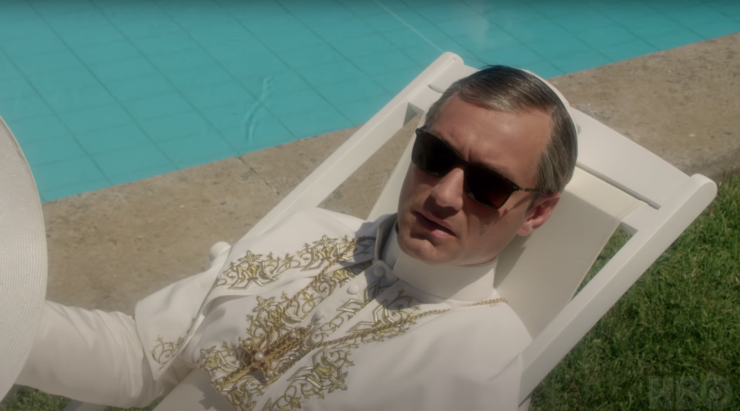
The thing I was trying to get at in Gideon was the way it threw slang and terrible puns and internet references into a blender with some High Gothic architecture, a haunted space castle, a bunch of Catholic imagery, actual martyrdom, and real bone-deep queer pathos—but I couldn’t crack what exactly I could say about them other than “Check out how cool this is!” and I don’t think anyone’s going to pay me for that take. But when I watched Sorrentino’s shows, a few things came into focus. First, for those of you who haven’t watched them, WATCH THEM. Second, understand that while some of the characters are homophobic, abusive, and cruel, the show is utterly queer-friendly and sex positive, and gently hints that the Church is a little too hung up on certain things, while also taking the idea of searching for God in a secular society completely seriously. As it continues it also tips further and further into outright speculative fiction.
The basic plot is simple: in the first season, the Church chooses a new pope, who is YOUNG, and also LOOKS LIKE JUDE LAW. The Cardinals and other churchly higher-ups assume he’ll be a malleable puppet, but he reveals himself as a vicious conservative who wants to drive gay priests out of the church and deny Communion to women who’ve had abortions. (He’s haunted, you see, by the fact that his parents abandoned him when he was 8, and he thinks that if he restricts people’s access to God, it will fill them with the same longing he feels for his parents. Plus, he’s just kind of a dick.) But over the course of the season he grows and changes. For reasons I won’t spoil, the second season needs a NEW POPE. This Pope is older, hence the show’s name change, but he’s also a flamboyant depressive English lord played by John Malkovich in eyeliner, who is very coy about his own sexuality, and who has to figure out how to Pope in the shadow of Jude Law.
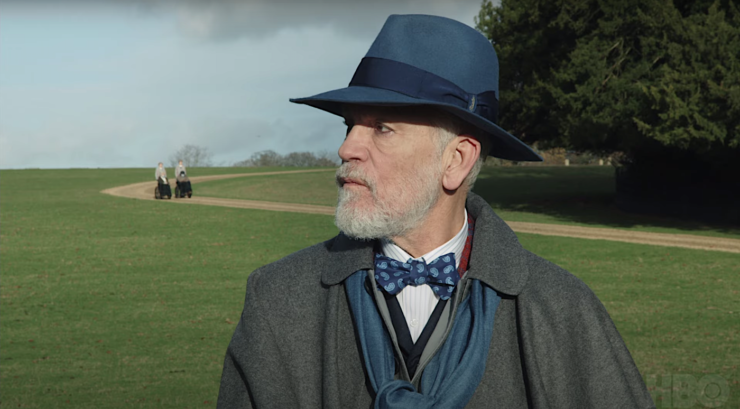
Again, the plot is just one thread of the show—I would argue that the show’s true success lies in its aesthetic, which is what helped me find my way into Tamsyn Muir’s work. The juxtaposition of high culture, abstract theology, the reality of death, the depth of belief, with the “vulgarity” of pop culture, internet slang, EDM, gyrating women. The Young Pope drinks a bottle of Cherry Coke Zero for breakfast, but also thinks extramarital sex of any kind is a crime against God. The scene that quickly became most notorious in the fandom was a scene of Pius XIII selecting an outfit for an address that was set to LMFAO’s “Sexy and I Know It”.
This juxtaposition is taken further in the second season, when the show opens with scantily-clad nuns dancing to “Good Time Girl.” This could be the age-old titillation of assuming things about the private lives of nuns, but the sequence is actually acting as a metaphor for the nuns’ fight for rights and autonomy within the Vatican. Plus John Malkovich’s Pope John III ups the queerness ante by wearing absurd bespoke suits, excellent smoky eyeliner, using the Papacy to broker a meeting with Marilyn Manson and being unable to sit in a chair:
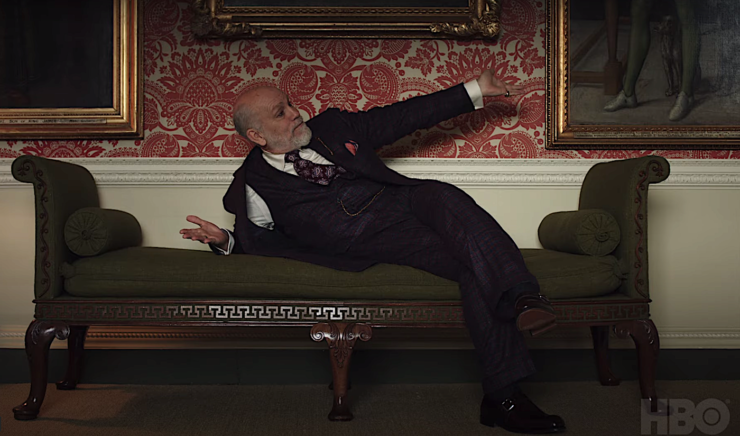
The best example of this aesthetic comes late in Season One. As part of his campaign to rebuild the Church’s sense of mystery, the Young Pope hasn’t allowed himself to be filmed or photographed, because he understands, like Harrow, that if you give people a bit of theater their own ideas about you will do some of your work for you. In the case of Harrow and Gideon, everyone assumes that they’re a dour, powerful necromancer and cavalier because of Harrow’s insistence on makeup, shrouding, and decorating their wing with ominous bones. Their brand is so strong that no one suspects (at first) that Harrow is the last of her house, or that Gideon’s command of a rapier is shaky at best. The other Houses happily buy into the theater. (Is there anything queerer than applying a Face to protect yourself from the straights?) In the same way, the Young Pope hides himself from his faithful, essentially to deny them an easy connection to God—basically he takes the church back to a much more rigid, top-down medieval system—so he addresses them by giving speeches, during thunderstorms, while shrouded in the Vatican. He is just a terrifying voice in the darkness, offering no comfort, only rules. So far, so Ninth House.
When the Pope visits a mission in Africa (and in one of the show’s only missteps, this is a fairly stereotypical fictional Band Aid-style “Africa”, not a nuanced view of a particular country or city) he is horrified by seeing the aftermath of the war that has raged in the unnamed country for over a decade. Having promised to give a speech he compromises—he still doesn’t appear in person, but instead leaves the audience staring at an empty seat on a stage while he broadcasts his speech. Now this alone, is a LOT. The empty throne obviously forces people to contemplate the absence of God, and the voice blaring through loudspeakers is kinda/sorta the Metatron. But the speech he gives is not another fire and brimstone extravaganza—instead he pleads for peace. The camera pans over the faces of the disgruntled journalists who just wanted a shot of the Pope, not these over-the-top theatrics; the pope’s staff, who are mightily sick of his shenanigans; soldiers with guns at the ready; the nation’s dictator; an audience of the faithful. As the pope says, “show me peace and I’ll show you God”, the camera rests on each face in turn, dissolving hierarchy, social status, political differences, denominations. And slowwwly, the music turns up. It’s an acoustic cover of Beyonce’s “Halo”, sung by Lotte Kestner. Here is a song that has played in every club and bachelorette party and girls’ trip and Fire Island house-share for over a decade, being stripped down into a quiet acoustic version, defamiliarized to help us hear the lyrics in a new way, and playing softly as we look into these faces.
https://www.youtube.com/watch?v=Dqb-2dkfFhI
This could seem silly, frivolous—but the camera slows down and contemplates each unique human face. They all seem to relax and open as the Pope begs people to embrace peace over war. A pop song is re-contextualized to be the Pope speaking to humanity—or God speaking to the Pope—to celebrate the idea that each human has intrinsic worth, apart from their nationality, their bank accounts, their social status. A radical idea in our modern world. This shouldn’t work. The clash between this earnest speech, the cliched images, the stripped-down version of one of the biggest pop hits of ‘00s? It should feel ridiculous. Instead the gap between the visuals and the song creates a space for vulnerability—grace, if you will.
Gideon shouldn’t work. The trash internet memes, the terrible puns, the Westing Game riffs, the titanic gothiness—and yet the sheer over-the-topness, the pathos of Gideon’s life, the guilt and loneliness of Harrow. And yet by going full tilt into what I’ve been thinking of as QueerGothCath, the book transcends all of the riffs and dad jokes and become truly moving.
Did I cry through the last pages? Yeah, yeah I fucking did.
I honestly didn’t expect it to Do The Thing. It was so fun and funny, that the inevitable thing, where Gideon has to fulfill her destiny of pain, seemed impossible. And then in the space of a few pages Muir made it inevitable, and gave us my favorite moment of queer Catholicism this side of Oscar Wilde’s deathbed conversion. Instead of a poverty-stricken brown socialist dying for everyone’s sins, we got a redheaded queer loser, dying for the love of a bone-painted goth nun. Rather than a public, state mandated execution, we get a private suicide as Gideon skips straight to the spear, the ultimate Fix Thing With Stab moment. Rather than a love scene between the two women we get endless longing capped with Love-In-Death.
I know I’ve talked about this theme once or twice before on this site, but it’s still so rare that when I see it I have to yell about it. The fact that queer and queer-friendly creators are actively staking a claim to religion in general and Catholic imagery in particular, after so many centuries of being alienated and shunned, gives me hope for the future. Reading Muir’s book, that leans so hard into a story of queer longing and sacrifice and never even hints at a disconnect between queerness and spirituality, watching Paolo Sorrentino’s gorgeous show that is about so many things, but becomes so explicitly a work of queer and feminist liberation theology. Basking in this art the celebrates maximalism and excess and joy, and is so bold in saying that it belongs to everyone, rewriting a story of torture and sacrifice in a way that centers the queer, the female, the weird, the liminal—I am choosing to believe that these are bold steps into a new canon.
Leah Schnelbach thinks that if there’s ever another entry in the Young Pope/New Pope Universe, it should be in SPACE because: Cherry. Coke. Zero. Gravity. Come join them in the Purgatorial flames of Twitter!










